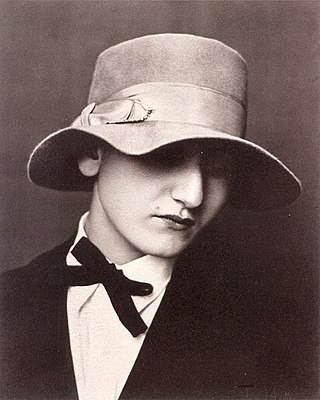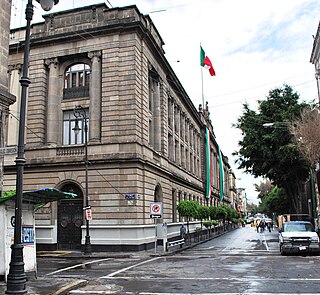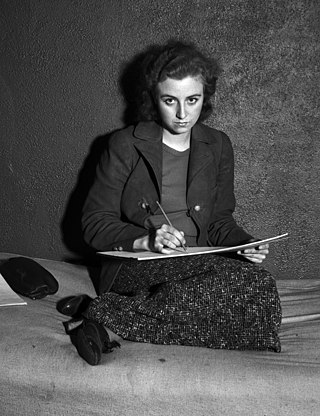Related Research Articles

Diego María de la Concepción Juan Nepomuceno Estanislao de la Rivera y Barrientos Acosta y Rodríguez, known as Diego Rivera, was a prominent Mexican painter. His large frescoes helped establish the mural movement in Mexican and international art.

José Clemente Orozco was a Mexican caricaturist and painter, who specialized in political murals that established the Mexican Mural Renaissance together with murals by Diego Rivera, David Alfaro Siqueiros, and others. Orozco was the most complex of the Mexican muralists, fond of the theme of human suffering, but less realistic and more fascinated by machines than Rivera. Mostly influenced by Symbolism, he was also a genre painter and lithographer. Between 1922 and 1948, Orozco painted murals in Mexico City, Orizaba, Claremont, California, New York City, Hanover, New Hampshire, Guadalajara, Jalisco, and Jiquilpan, Michoacán. His drawings and paintings are exhibited by the Carrillo Gil Museum in Mexico City, and the Orozco Workshop-Museum in Guadalajara. Orozco was known for being a politically committed artist, and he promoted the political causes of peasants and workers.

Tina Modotti was an Italian photographer, model, actor, and revolutionary political activist for the Comintern. She left Italy in 1913 and moved to the United States, where she settled in San Francisco with her father and sister. In San Francisco, Modotti worked as a model and, later, as a photographer. In 1922 she moved to Mexico, where she became an active member of the Mexican Communist Party.

Vittorio Vidali, also known as Vittorio Vidale, Enea Sormenti, Jacobo Hurwitz Zender, Carlos Contreras, and "Comandante Carlos", was an Italian communist. After being expelled from Italy with the rise of Fascist Benito Mussolini, he went to Moscow, where he became an operative for the Soviet Comintern. He was exiled to Mexico, where he was implicated in assassination attempts of Cuban communist Julio Mella and Russian revolutionary Leon Trotsky. Later Vidali was active in other locations, finally leading the new communist part in the Free Territory of Trieste beginning in 1947 after World War II. He later represented the community in Parliament after it was annexed by Italy.

Julio Antonio Mella McPartland was a Cuban political activist, journalist, communist revolutionary, and one of the founders of the original Communist Party of Cuba. Mella studied law at the University of Havana but was expelled in 1925. He had worked against the government of Gerardo Machado, which had grown increasingly repressive. Mella left the country, reaching Central America. He traveled north to Mexico City, where he worked with other exiled dissidents and communist sympathizers against the Machado government. He was assassinated in 1929, but historians still disagree on which parties were responsible for his death. The 21st century Cuban government regards Mella as a communist hero and martyr.

Louis Henri Jean Charlot was a French-born American painter and illustrator, active mainly in Mexico and the United States.

Luz Jiménez or Luciana was an indigenous Mexican model and Nahuatl-language storyteller and linguistic informant from Milpa Alta, D.F.

Mexican Muralism refers to the art project initially funded by the Mexican government in the immediate wake of the Mexican Revolution (1910-1920) to depict visions of Mexico's past, present, and future, transforming the walls of many public buildings into didactic scenes designed to reshape Mexicans' understanding of the nation's history. The murals, large artworks painted onto the walls themselves had social, political, and historical messages. Beginning in the 1920s, the muralist project was headed by a group of artists known as "The Big Three" or "The Three Greats". This group was composed of Diego Rivera, José Clemente Orozco and David Alfaro Siqueiros. Although not as prominent as the Big Three, women also created murals in Mexico. From the 1920s to the 1970s, many murals with nationalistic, social and political messages were created in many public settings such as chapels, schools, government buildings, and much more. The popularity of the Mexican muralist project started a tradition which continues to this day in Mexico; a tradition that has had a significant impact in other parts of the Americas, including the United States, where it served as inspiration for the Chicano art movement.

Anita Brenner was a transnational Jewish scholar and intellectual, who wrote extensively in English about the art, culture, and history of Mexico. She was born in Mexico, raised and educated in the U.S., and returned to Mexico in the 1920s following the Mexican Revolution. She coined the term 'Mexican Renaissance', "to describe the cultural florescence [that] emerged from the revolution." As a child of immigrants, Brenner's heritage caused her to experience both antisemitism and acceptance. Fleeing discrimination in Texas, she found mentors and colleagues among the European Jewish diaspora living in both Mexico and New York, but Mexico, not the US or Europe, held her loyalty and enduring interest. She was part of the post-Revolutionary art movement known for its indigenista ideology.

María Dolores Velázquez Rivas, better known as "Lola" Cueto was a Mexican painter, printmaker, puppet designer and puppeteer. She is best known for her work in children's theater, creating sets, puppets and theatre companies performing pieces for educational purposes. Cueto took her last name from husband Germán Cueto, which whom she had two daughters, one of whom is noted playwright and puppeteer Mireya Cueto. Most of Cueto's artistic interest was related to Mexican handcrafts and folk art, either creating paintings about it or creating traditional works such as tapestries, papel picado and traditional Mexican toys.
Amado de la Cueva was a Mexican painter. De la Cueva studied in Rome. After his return to Mexico in September 1922, he painted amongst others together with Diego Rivera his murals at the Secretaría de Educación Pública. On October 16, 1923, he returned to his home town, where he painted the murals at Universidad de Guadalajara's assembly hall together with David Alfaro Siqueiros and Carlos Orozco after 1925.
María del Carmen Mondragón Valseca, also known as Nahui Olin, was a Mexican painter, poet, and artist's model.

Ramón Alva de la Canal was a Mexican painter, illustrator, and educator, one of the pioneers of the Mexican muralism movement.

Stridentism was an artistic and multidisciplinary avant-garde movement, founded in Puebla City by Manuel Maples Arce at the end of 1921 but formally developed in Xalapa where all the founders moved after the University of Veracruz granted its support for the movement. Stridentism shares some characteristics with Cubism, Dadaism, Futurism and Ultraism, but it developed a specific social dimension, taken from the Mexican Revolution, and a concern for action and its own present. Stridentists were part of the political avant-garde, in contrast to the "elitist" modernism of Los Contemporáneos.

Fernando Leal was one of the first painters to participate in the Mexican muralism movement starting in the 1920s. After seeing one of his paintings, Secretary of Education José Vasconcelos invited Leal to paint at the Escuela Nacional Preparatoria. The resulting work is Los danzantes de Chalma. Leal also painted a mural dedicated to Simón Bolívar at the Anfiteatro Bolivar, as well as religious murals such as those at the chapel dedicated to the Virgin of Guadalupe at the Basilica Villa in Tepeyac.

Xavier Guerrero was one of the pioneers of the Mexican muralism movement in the early 20th century. He was introduced to painting through working with his father, who worked in masonry and decorating. However, there is evidence that his ability was mostly self-taught. In 1912, he moved to Guadalajara and began painting murals, then to Mexico City in 1919 just as the muralism movement was about to begin. Most of his work was in collaboration with or subordinate to other painters such as Diego Rivera and David Alfaro Siqueiros, working at the San Ildefonso College, the Secretaría de Educación Pública building and the Universidad Autónoma de Chapingo; however, much of his other work has been lost. While best known for his mural work, his later canvas work is considered to be better.

Concha Michel (1899–1990) was a Mexican singer-songwriter, political activist, playwright, and a researcher who published several projects on the culture of indigenous communities. She was one of the few women who performed in the corrido style. She created the Institute of Folklore in Michoacan and was one of the first collectors of folklore and preservers of the traditions of the Mexican people. She was a cultural icon having relationships with two presidents, and a broad range of Mexico's most prominent artists including Diego Rivera, Frida Kahlo, Guadalupe Marín, Tina Modotti, Elena Poniatowska, Anita Brenner and others.

Ione Robinson was an American artist, writer and socialite. She is most known for her reporting of the Mexican muralist movement, especially episodes on Diego Rivera and David Alfaro Siqueiros, in her book A Wall to Paint on (1946). In this book, she reported also her experiences from the Spanish Civil War, that she witnessed in Barcelona in 1938.

Margaret Hooks (1945–2021) was an Irish-born author and journalist, best known for her books and writing about women, art and photography, including a celebrated biography of the Italian-born photographer Tina Modotti, and books and articles about Surrealism and artists related to the Surrealist movement.
References
- 1 2 Rick A. Lopez (19 August 2010). Crafting Mexico: Intellectuals, Artisans, and the State after the Revolution. Duke University Press. p. 108. ISBN 978-0-8223-9173-9.
- ↑ Susan Provost Beller (1 September 2008). The Aftermath of the Mexican Revolution. Twenty-First Century Books. p. 107. ISBN 978-0-8225-7600-6.
- ↑ Tina Modotti; Patricia Albers; Karen Cordero (2000). Tina Modotti: the Mexican renaissance. Jean-Michel Place editions. p. 16.
- ↑ "The Mexican Mural Renaissance". Jean Charlot.com. Retrieved 17 December 2013.